After ~3 years of trying, I have made so many Tartine bricks, hockey pucks and frankenloafs that I doubt I can ever make the beautiful perfect Tartine Country Loaf. Case in point, here's my loafs from last week:
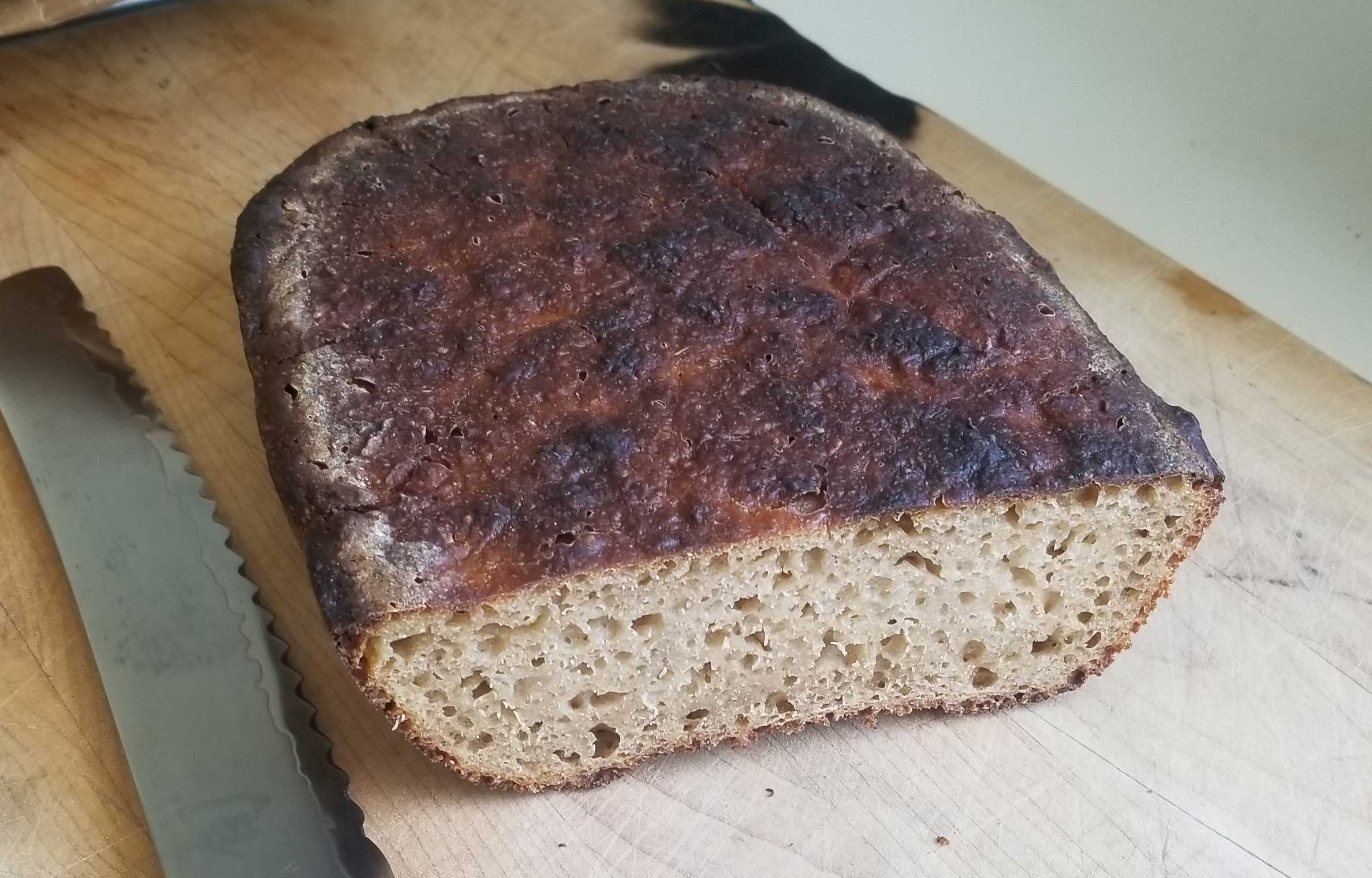
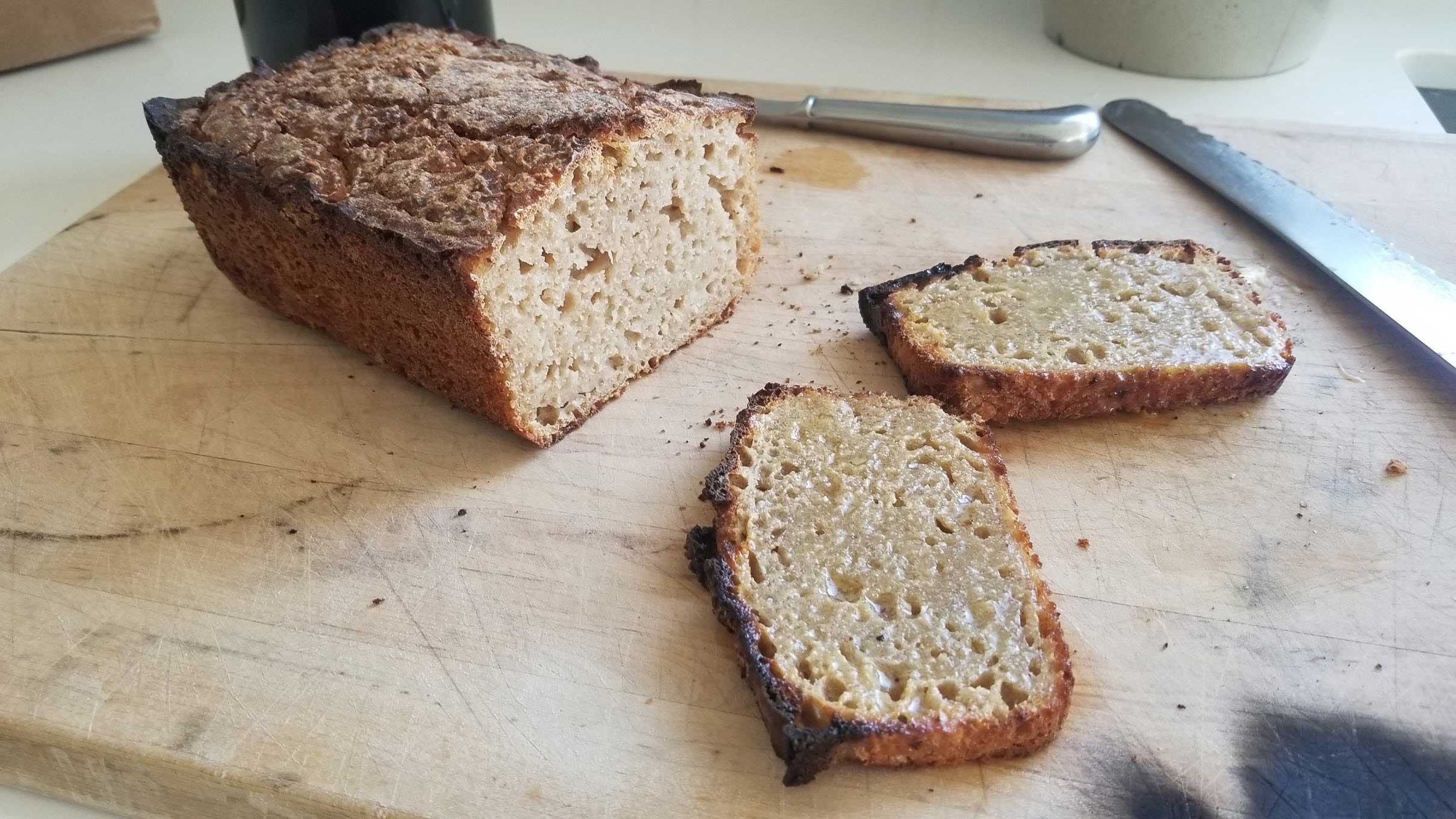
Last week's loafs looked decent going through bulk fermentation, but when I got to shaping, it was a disaster as you can see below: No elasticity, crumbly, flat, runny... it broke off as I pulled the bottom out for shaping. I just scooped up this disaster in a pyrex and baked it.
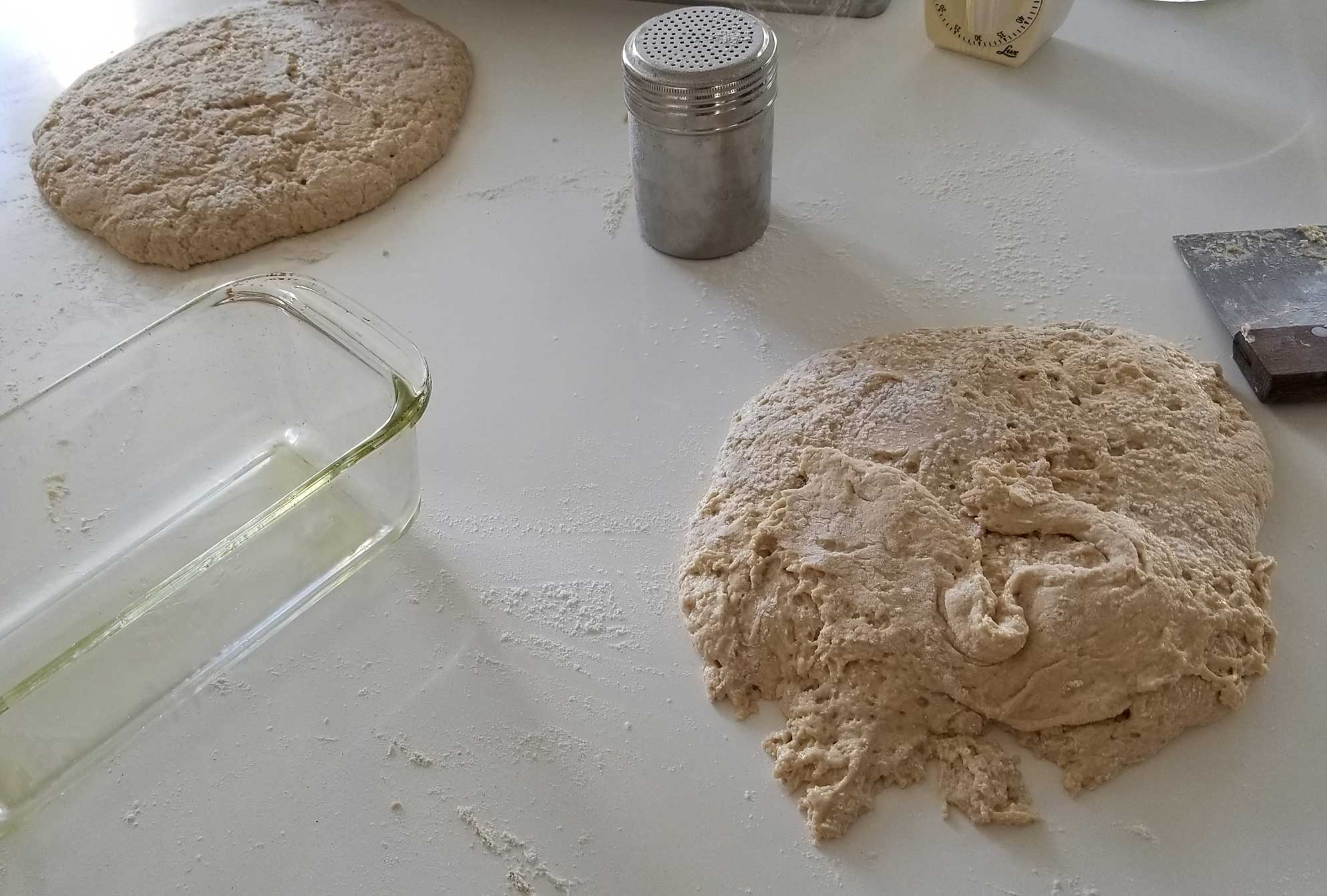
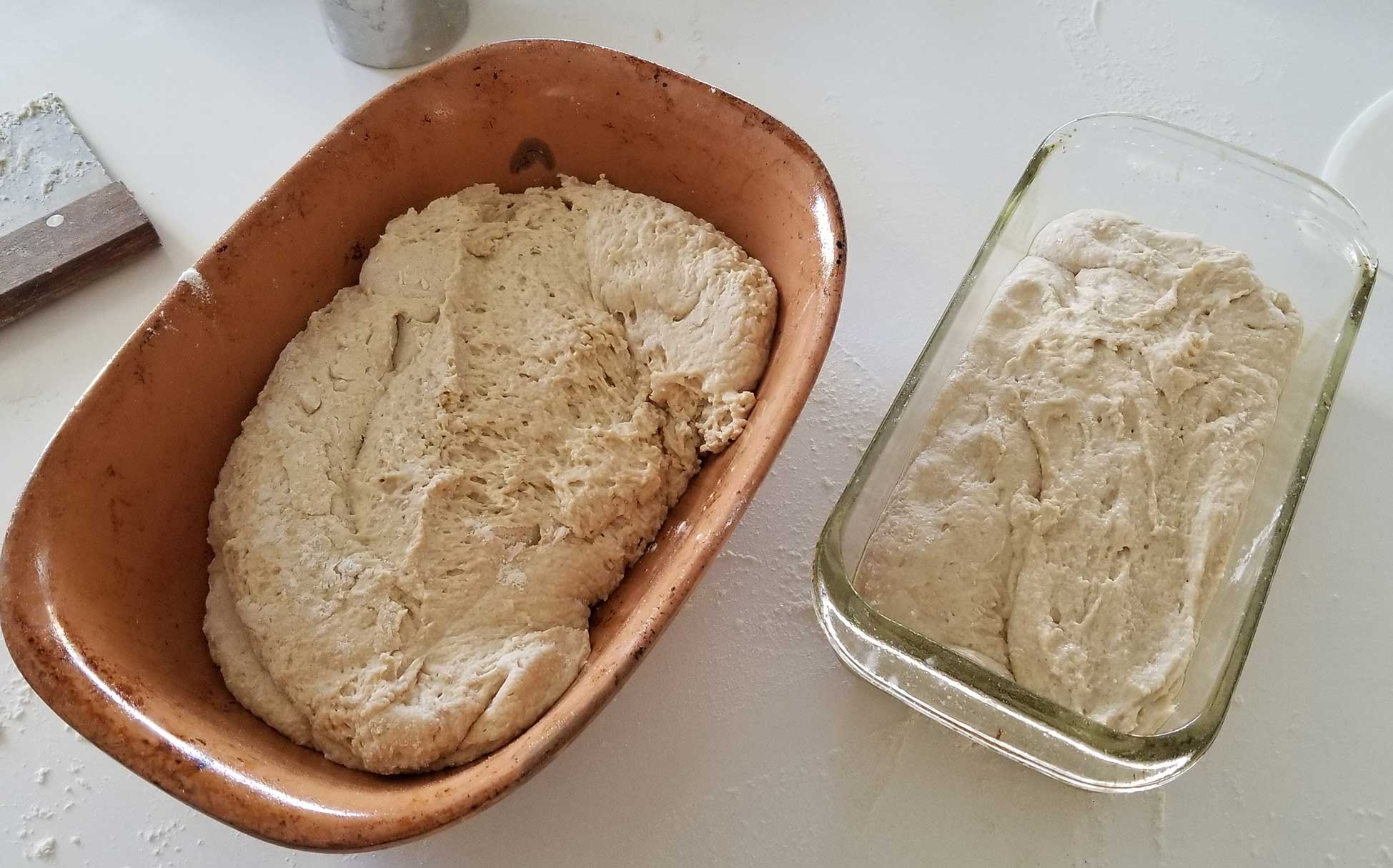
My loaf the week before last (shown below) was also a disaster. Same sort of issues: flat, runny, no elasticity, couldn't shape.
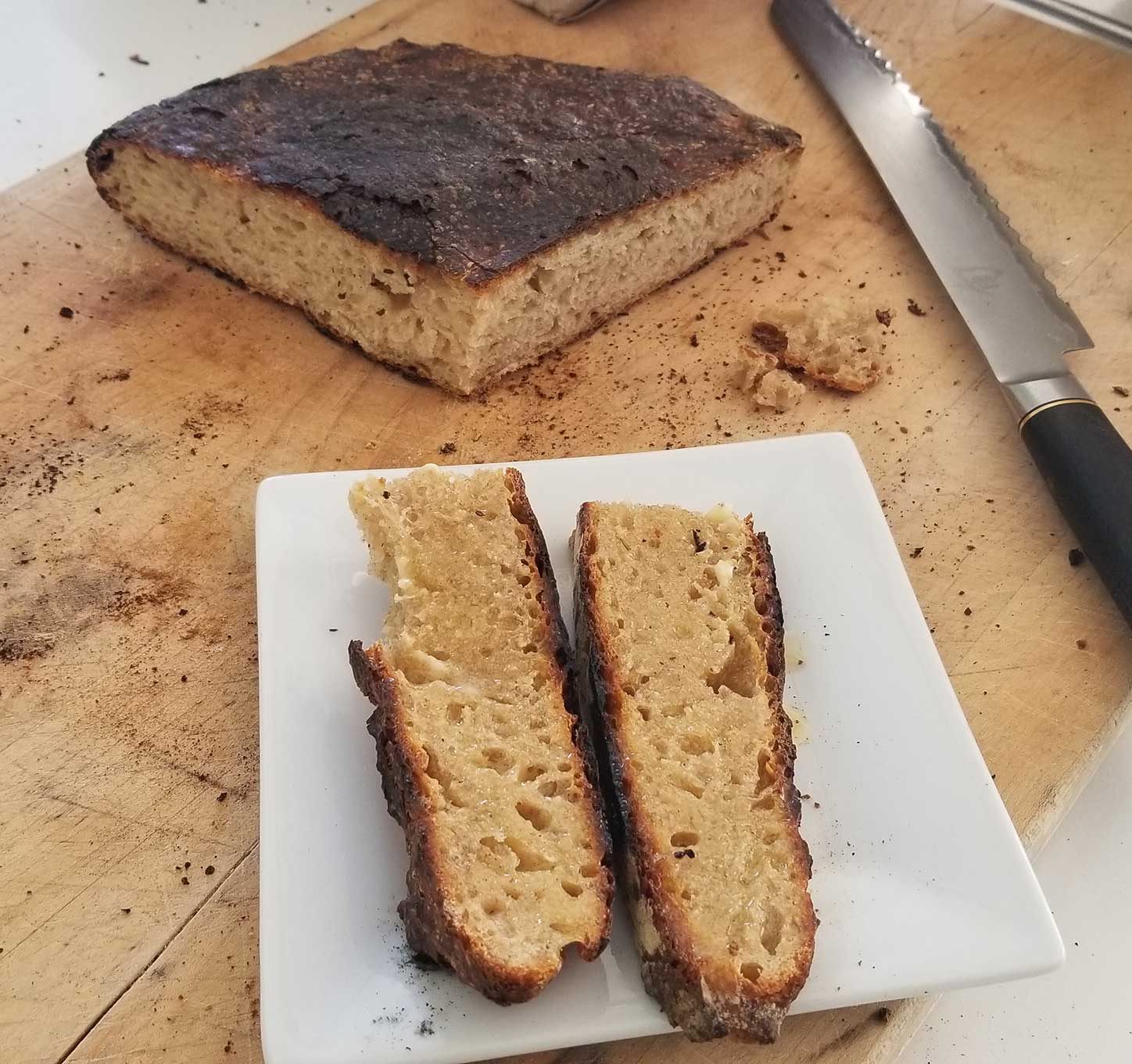
A couple of weeks before this, I actually made a couple of hockey sticks to go with this big old hockey puck above. You can see those below. For the hockey sticks I deviated from the classic Tartine recipe I used to make the hockey pucks and bricks above and used a classic french bread baguette recipe (i.e., used bakers yeast and not my starter). Still, due to poor shaping or something else, they were sort of flat and ... well, you can see below...
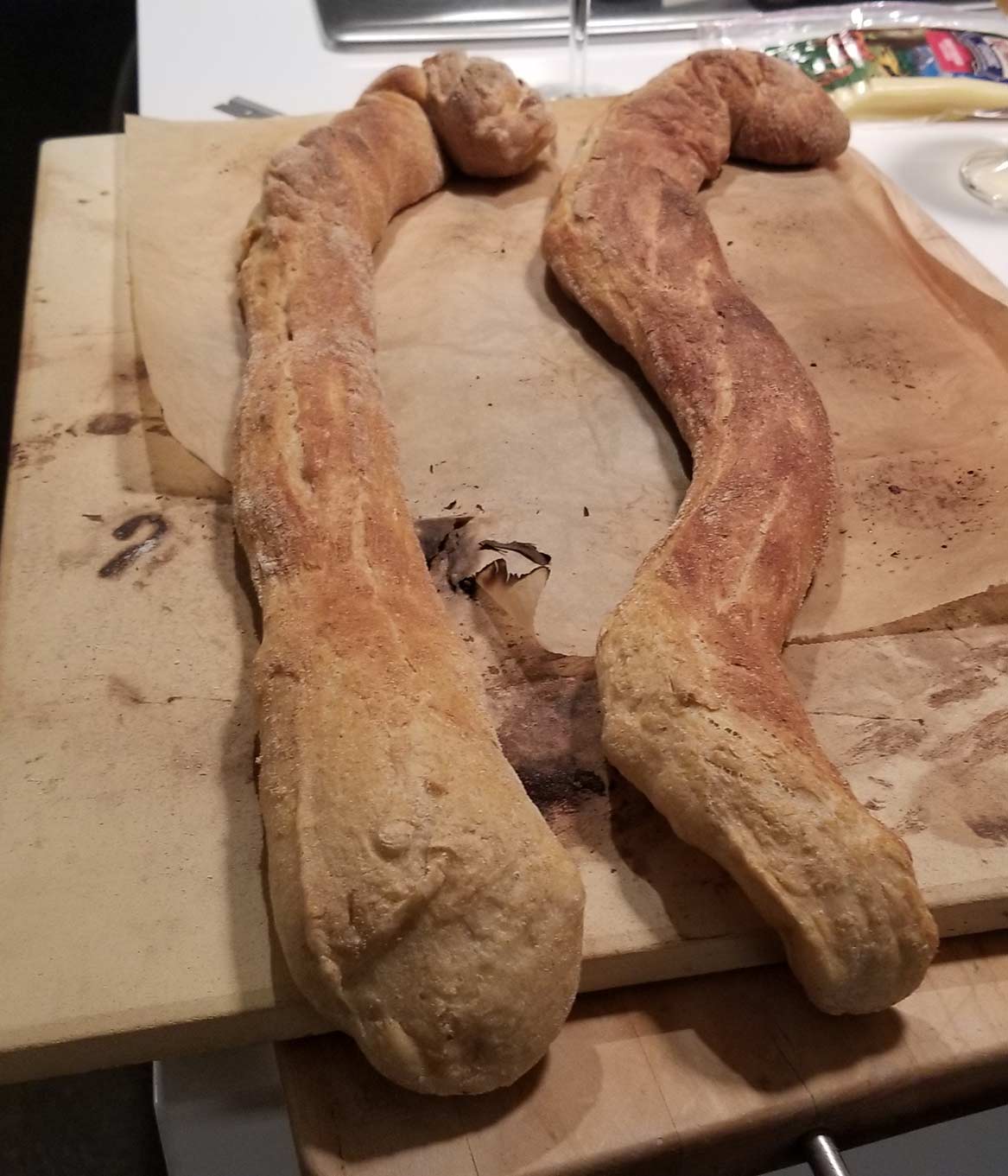
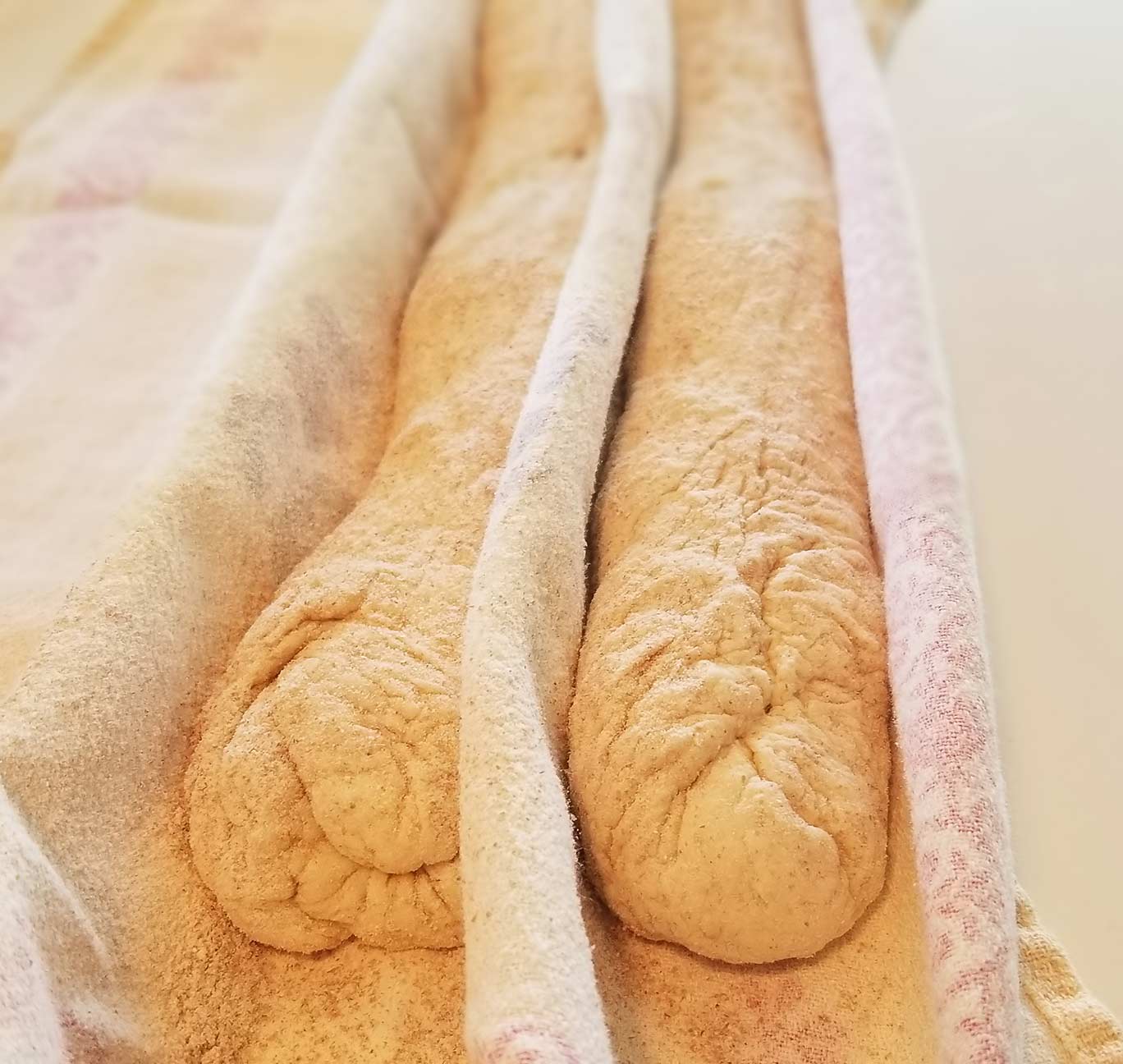
Actually my butcher-every-loaf-I-make is not quite true. A couple of months ago while we were still early in shelter-in-place I made (apparently quite by accident) this beauty:
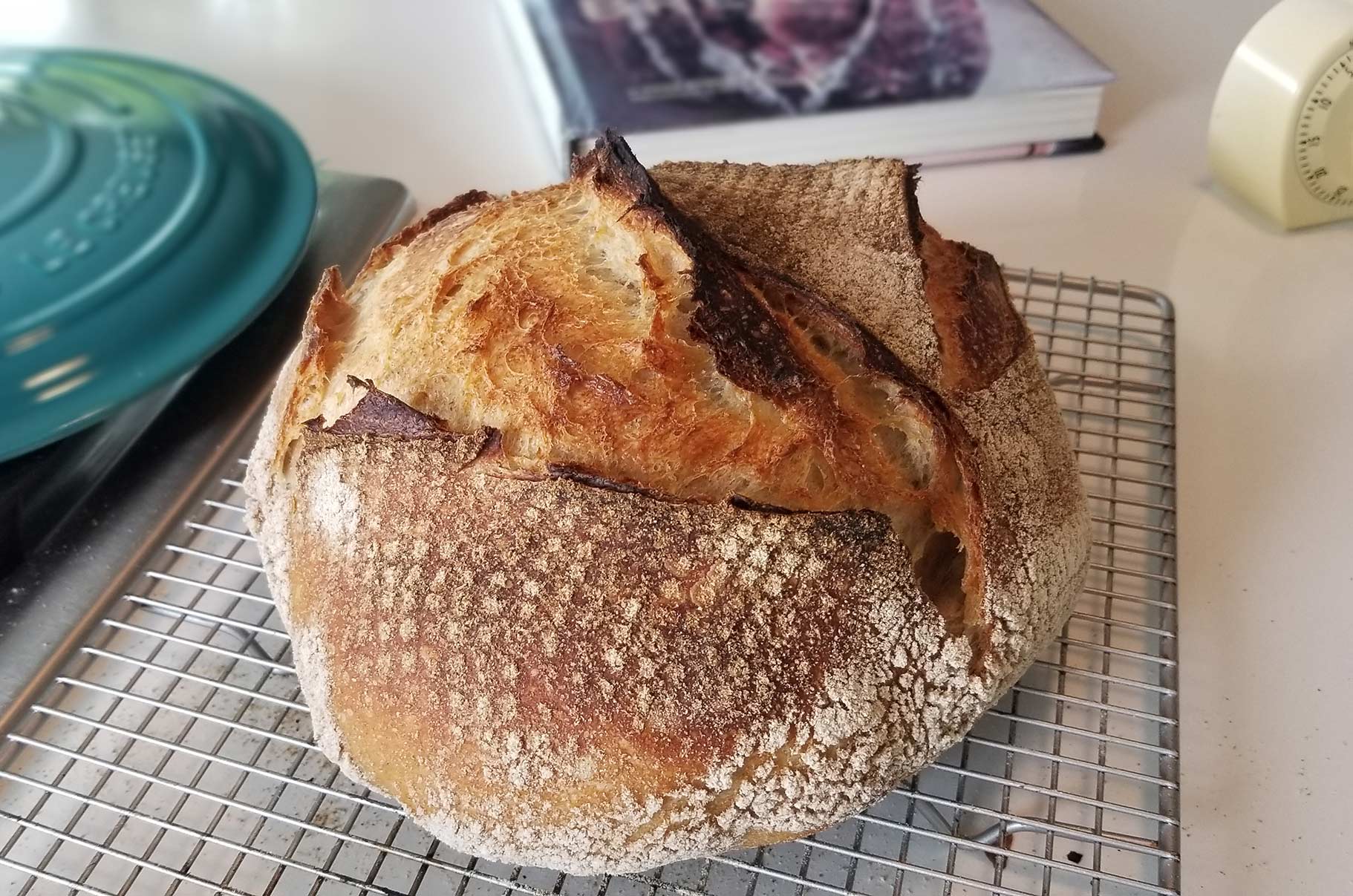
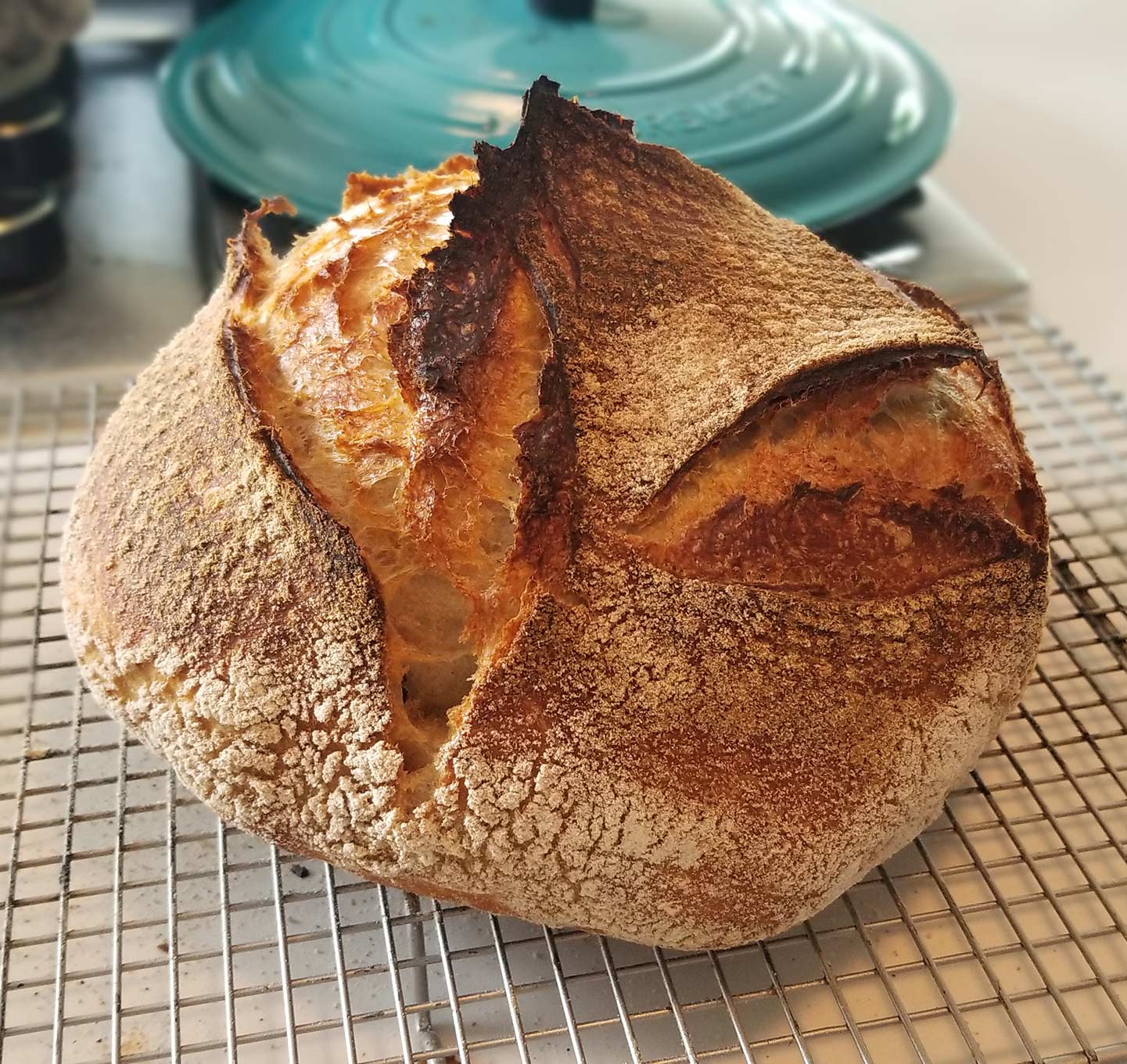
That was probably the problem. That loaf was a fluke. Bricks, hockey pucks and frankenloafs have been par for the course since then. So, I'm trying to use this post to chronicle my future breadmaking and get some advice for what I'm doing wrong ... or dedicate a thread on how exactly to screw up 1000grams of flour.
Unless otherwise noted, my recipe is the Tartine Country Loaf. I follow the recipe directly from the book ... pages 45-65 of my Tartine book are so crusty you can probably bake them into an edible loaf ;-) ... I.e., 75% hydration, 450g bread flour, 450g AP flour, 100 whole wheat flour, 25g salt that goes in with 50g water after 30min autolyse rest. My starter rises and falls predictably. I feed it once per day. My levians look great ... light, young fresh smell, easily pass the float test. My autolyse and bulk fermentation seem to go great. I fold the dough (3 or 4 turns in my deep glass vessel) every 30min for the first three hours then either lightly turn or skip turns every 30min after that.
Then disaster usually strikes when it comes to shaping as you can see from the loafs at the top. Here is what I think my problem was in the top 3 flat loafs: didn't have bread and AP flour (usually use King Arthur) so I substituted Capay Mills flour instead (Big Bug in the loafs last week and Chiddam Blanc de Mars the big flat hockey puck). I think that, plus me letting bulk fermentation run 5 or 6 hours was my downfall.
Will correct this and let you know how it goes next time. In the meantime, comments/tips/other areas to explore welcome.
Welcome to TFL.
Are you using chlorinated tap water? (IE, "city water"?) Are you using house tap water that has passed through a "water softener" ? If yes to either, try bottled _spring_ water. (Not filtered water, not bottled "purified" water.)
Just looked up Chiddam Blanc de Mars. One web page says it's a pastry flour. If that's so, it can't make decent bread when sustituted for AP or Bread flour. Any risen loaf bread made with much of that will be a disaster.
If by "Big Bug" you actually meant "Red Bug" from Capay, that is a whole grain flour. Totally fine for the whole wheat portion of a formula, but not for substituting the AP or bread flour.
Thanks for the welcome. Yes, I suspect that the Chiddam Blanc de Mars was the primary cause of my failure for the big round flat hockey puck loaf. I had been using King Arthur almost exclusively but then SF ran dry of AP and bread flour for most of March through May. I still can't find King Arthur bread flour in any store in SF. I had to use what was available and tried the Chiddam, knowing it was pastry flour. Working with that flour was very strange: no window pane, stuff would rip when stretched. No elasticity. Impossible to shape and form tension on the bench.
The "Big Red Bug Blend" from Capay is similar to their "Red Bug". Details are not on their website but it's 58.5% Wit Wolkering heirloom hard white wheat with 40% WB 9229 hard red wheat and 2.5% malted barley. The bag says "Big Red Bug is an ideal flour for naturally leavened country breads" and that it has "strong gluten properties." This loaf then (last weeks' loaf) should have turned out okay but also failed. I think my problem with this one was that I let the BF go too long--a solid 6 hours--because at the 4 hour mark the float test was inconclusive. I think the yeast went through all the sugars and started eating away the gluten is my guess.
Good comment on water: I'm using San Francisco tap water--I.e., good ole Hetch Hetchy ... which, along with NYC water in the winter are the two best tasting out of the tap waters in the world IMO. I'll explore spring water. Thanks for the suggestions.
"This loaf then (last weeks' loaf) should have turned out okay but also failed. I think my problem with this one was that I let the BF go too long--a solid 6 hours--because at the 4 hour mark the float test was inconclusive. I think the yeast went through all the sugars and started eating away the gluten is my guess. "
I'm on the Autism spectrum, so it's still unclear to me if you used this whole wheat flour as 100% of the flour in your loaf, or you used it as the 10% whole wheat flour called for in the recipe.
( --- Unless you make a discernable chart/list, I can't keep mental track of "casual mention" type descriptions of what went into what week's loaf -- you verbally bounced around the time-line too much. --- The upside of Asperger's is that the anal-retentive attention-to-detail makes for good consistency and repeatability, which are essentials in reproducing consistent results in baking. ---)
If you used that whole wheat as the 10%, that's fine. (Then the pastry flour was totally at fault.)
If you used it at 100%, then that is a typical newbie mistake... because... whole wheat flour is not a direct substitute for white flour ("Bread" or "AP"). You can't sub in whole wheat (or "high extratction") for all the white flour. In fact, you need a whole new formula (recipe). (---Small--- percentages can be subbed, then various adjustments made, but it is very much easier to just start with a formula that matches the ingredients you want or have. Why re-invent the wheel?)
I forget if Tartime Bread has any 100% whole wheat formulas. (It's upstairs and I'm too lazy right now.)
In Petaluma, there is Keith Giusto Bakery Supply, www.kgbakerysupply.com, which may have the right white flour for you. Check their web site. You may have to buy a 50 pound bag. If you don't require organic, you'll pay under $30 for a 50 pound bag. Tell them what Tartine formula you are using, and they'll tell you what matches well.
"Red Rose" is their non-organic line.
Yeah, I did use that whole wheat flour (the Big Red Bug) as the 100% of my flour my and yes, that was my mistake. So, i think I have closure on reason for failure for those 2 previous loafs. Wrong flour, at least for the recipe. The Tartine book does have a whole wheat recipe, you have a good suggestion that perhaps I try that recipe if I were to use the whole wheat again.
I found the Keith Guisto Bakery Supply in Petaluma. Actually bought online from Central Milling and they directed me to Keith Guisto Bakery Supply to pick up the order. Take a look at my latest post below for how I screwed up that loaf. :-)
Perhaps I could also use a little more Aspergers to get more focus and attention to detail on my breadmaking. My ADHD approach is not doing so well.
Appreciate your help and advice. Thanks!
One thing I would do as a relatively new sourdough baker is to reduce the hydration to around 70%. That little decrease in hydration will make your dough so much easier to deal with. It is possible that your flour just isn't absorbing all the water you are giving it and it ends up causing the sticky runny mass that you're trying to shape. I've been there and reducing the hydration really helps. I always reduce the hydration the first time I try a new recipe.
Benny
That's a good tip. Quite frankly it was probably a mistake for me to have never made a loaf of bread ever in my life to jump straight to the Tartine Country Loaf. I should have started with some lower hydration loafs that use bakers yeast and worked my way up.
Only recently, after stumbling along and not really perfecting the Tartine loaf for the better part of 3 years, did I crack open The Bakers Apprentice book and try some "easier" (lower hydration, easier to work with dough, bakers yeast hydrated with sugar water first, etc..) recipes from that. The dough was shockingly much different/easier to work with than the wet Tartine loaf. In fact, after about 4 of those French and Italian breads under my belt I switched back to the Tartine loaf and made the best looking loaf of my life (which you can see in the photos above. Excited about that, I went back full steam ahead into the Tartine loaf with 2 solid months of failure.
Well you’ll get your mojo back with Tartine yet, just reduce hydration and everything will be very different in a better way. Make sure you report back, lots of experienced bakers here to help you as they have helped me and each other.
Benny
... another couple of bricks. Damn. This one was going so well. I found some AP flour (Gold Medal) and drove up to Central Milling in Petaluma to buy some bread flour (Organic Type 70 Malted, "Organic, high-extraction bread flour") so I went back to the original flour ratios (450g AP, 450g bread, 100g King Arthur whole wheat). Followed the Tartine instructions to a tee. Levain looked good, passed the float test, mix and autolyse looked great. Did my usual folds through 4 hours of BF.
At the 4th hour of BF, I determined that BF was not quite done. On that note of whether BF is "done", the dome and the indent tests are not good indicators for me. My doughs are always domed, you form a ball out of the dough and you get round / domed edges. I don't get it. Is my dough flat? No, it alway has a dome, it's never flat. And my dough always indents when I poke it ... so I don't understand or use these tests/indicators.
My tests for BF completion are volume increase, visible (through my glass container) air pockets, and what I call the "jiggly" test. Gently put your five fingers on the top of the dough and lightly shake them back and forth rapidly. When the dough jiggles with your movement that's my indicator that it's done.
Anyway, for this loaf, after seeing that it wasn't jiggly and volume was probably only at about a 20-30% increase, I left my dough to sit in the late afternoon sun (covered of course) and went out to do some gardening. Come back in 2.5 hours later and I realized that was a big mistake. 6.5 hours total BF in a warm sun - Dough was now frothing over the top of the container. Probably a 100% increase in volume. It was jiggly as hell and poured onto the bench like it was water.
Just like my last three loafs, these were impossible to try and shape. Even after a giving them a relatively long (50min) bench rest to cool them down. I'm now an expert on telling when the dough has no/low glutens ... in this case my guess is the yeast ate through all the sugars and then started eating all the protein/gluten. The dough did not have a soft, taut, smooth surface. It looked like cottage cheese. About as easy to shape as cottage cheese as well :-(
I got out the ole pyrex and my other ceramic baking vessel, scooped up the dough into it .... it rose about another 20% in that for another 2 hours before I baked it. Results are two more bricks / Tartine franken loafs as you can see below.
I'm not discourage, because i think I know how I screwed this one up - BF went way too long. But I'm at a complete low point in my 3 years of baking. I've never baked this many back to back disasters. Think I'm going to switch to a different (easier) recipe so I can get back to some wins. Eyeing this one: https://www.theperfectloaf.com/sourdough-bread-with-all-purpose-flour/ but if anyone has any other thoughts/recipes, send them my way.
p.s. while very dense and chewy, the taste on these loafs are pretty good. They are more sour than I would like, but the crust has that very nice, crunchy, nutty, carmel-like, hint of burned, stick to the bottoms of your teeth experience that I like in the Tartine loafs.
Whenever you get new flour, even if it is the same flour you’ve had before, you probably want to hold back some water because you don’t know how thirsty the flour is going to be. Anyhow, I totally get your frustration. A lot of bakers here start out with the 1 2 3 sourdough. There was even a Community Bake featuring this recipe. 1 2 3 Soudough Community Bake. Why don’t you have a read through that recipe. When I first started out baking Sourdough I was trying Maurizio’s Beginner Sourdough and posted here about my troubles. It turns out I wasn’t subtracting his hold out water from the mix and was using the total water in the mix and then adding the hold out water later on. Once I figured that out, and reduced the hydration further, I had some success. Then I baked that recipe over and over until I kind of felt a bit more confident at it. That recipe is Beginner’s Sourdough but again reduce the hydration by at least 5%. Maurizio lives in desert conditions so most of the rest of us live in places with higher humidity so our flours start out more hydrated when dry than his.
Benny
I'm not an expert baker, I've only been at it a few years myself, but when I first started I tried Tartine's regular loaf and it was a disaster. I know this style is super popular, but honestly I think it's bad for beginners (you can see my thoughts on this here: http://www.thefreshloaf.com/node/64550/why-open-crumb#comment-460235). Maybe others have had better luck starting out with it. In addition to the Bread Baker's Apprentice as an all around great bread book for beginners, I recommend Trevor Jay Wilson's PDF: http://www.breadwerx.com/open-crumb-mastery/. I found it had much better explanations of how to treat your doughs to get a certain crumb, and excellent explanations on how fermentation relates to final crumb structure. It's more of "why" book than a recipe book, but I remember reading it and wishing those why's were better explained in Tartine. Don't beat yourself up!
Thanks for sharing the link. Comforting to see others have had the same experiences as me. Thanks for sharing Trevor Jay Wilson's PDF.
Okay, back at it. This time, taking advice of folks here, I'm simplified by going with a beginners recipe from The Perfect Loaf - https://www.theperfectloaf.com/sourdough-bread-with-all-purpose-flour/. Although, in typical of fashion of not quite following the recipe exactly, instead of doing 100% AP flour, I did 45% AP, 45% bread flour, 10% whole wheat. I also did a 30min autolyse then added the reserved 50g water and 12g salt.
Even though it was doing BF covered by a sunny window, I couldn't resist the urge to let go past the 3.5 hours. I started shaping after 4 hours and 10min of BF. Shaping went smoothly. Looked like real dough that held it's shape, unlike my last three loafs. Did 2.5 hours of poofing and then baked.
Results are below. I immedately noticed that my loaf didn't have the high ears in the crust and big air pockets in the crumb, Perhaps this recipe doesn't facilitate that, or those breakmaking skills still elude me? I didn't miss the pockets as this loaf was for toast and not dipping but I like the crunch of the big ears. Nevertheless, it tasted fantastic. Crisp, nutty, carmelly crust that sticks to the bottoms of your teeth. Soft, billowy crumb. Like the Tartine loafs, a little nerve wracking cutting into early on because the crust takes some effort to cut into, putting pressure on a very soft and pillow crumb. Just want I was looking for.
Thanks for the encouragement and tips.
Just to make sure that last bake wasn't a fluke, to get back in the swing of things and because we ate through that last loaf so quick I baked another.
Followed the same recipe and process as the previous (June 13) loaf ... right down to the freakout of thinking it would be too early if I ended BF at 3.5 hours so went to 4 hours again. Results turned out pretty much the same as the June 13th loaf in taste and flavor ... but again no ears and holes. Also, it had a little less oven spring / the dough spread out a little more. I suspect because it was a slightly warmer day? Didn't help that t "missed" when it came time to "drop" my loaf (on some too small parchment paper) into my deep Le Creuset. Some of the edge of the loaf caught on the side of the Le Creuset, stretching into a big "duck tail" ear after it baked. I cut that off before taking the pictures here..
Fast consumption of the loaf is a good sign. Taste and mouth-feel (that's actually a word) eventually trump visual appeal.
Yeah, oven-spring and "ear" generally depend on a slightly underfemented loaf.
Here are some nice short videos by user Dan Ayo that show some of his experience getting good oven spring and ears:
www.youtube.com/channel/UC7mXjnPpTDoVJxRdrG3ZeYw/videos
Wow, those videos are great. Especially the early ones about over- and under-proofed breads. Watch those two things strike me: 1) In general I am way over developing my loafs. I had generally been doing about about 6 hours of BF and 4 hours of proofing ... add to that about 1.5 or so extra hours for autolyse, benchrests, etc... and I had generally been putting about 12 hours in from mixing to baking. Probably too long. 2) vindicated that, like me, this guy points out that the finger poke test is worthless at best and potentially misleading. Thanks for sharing.